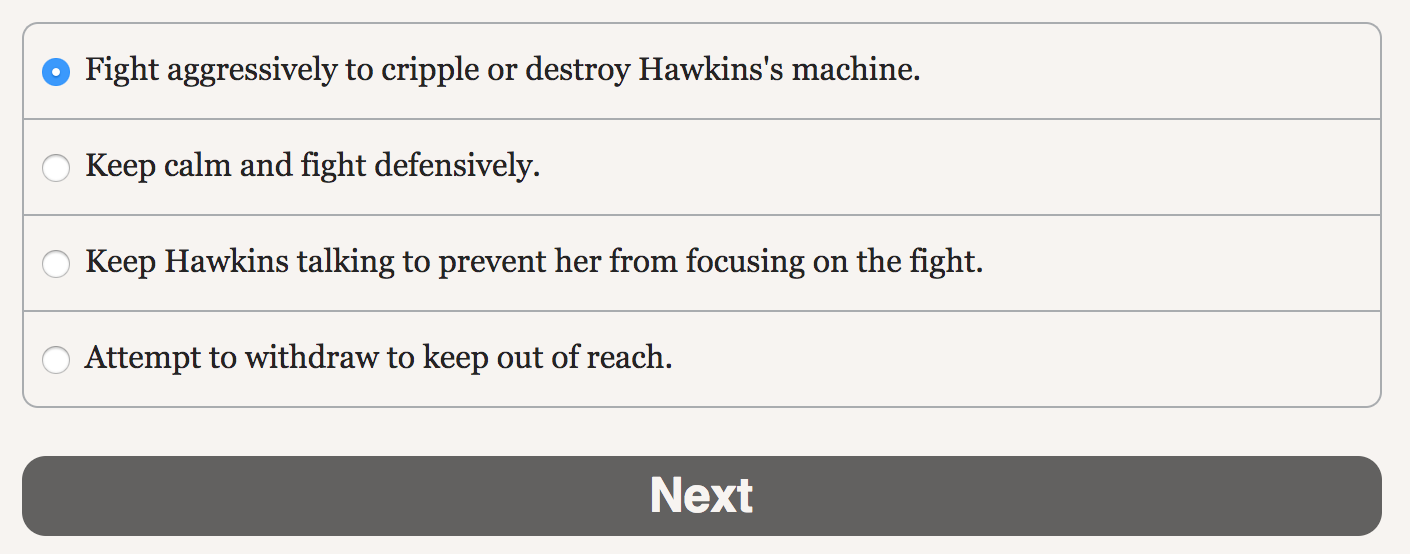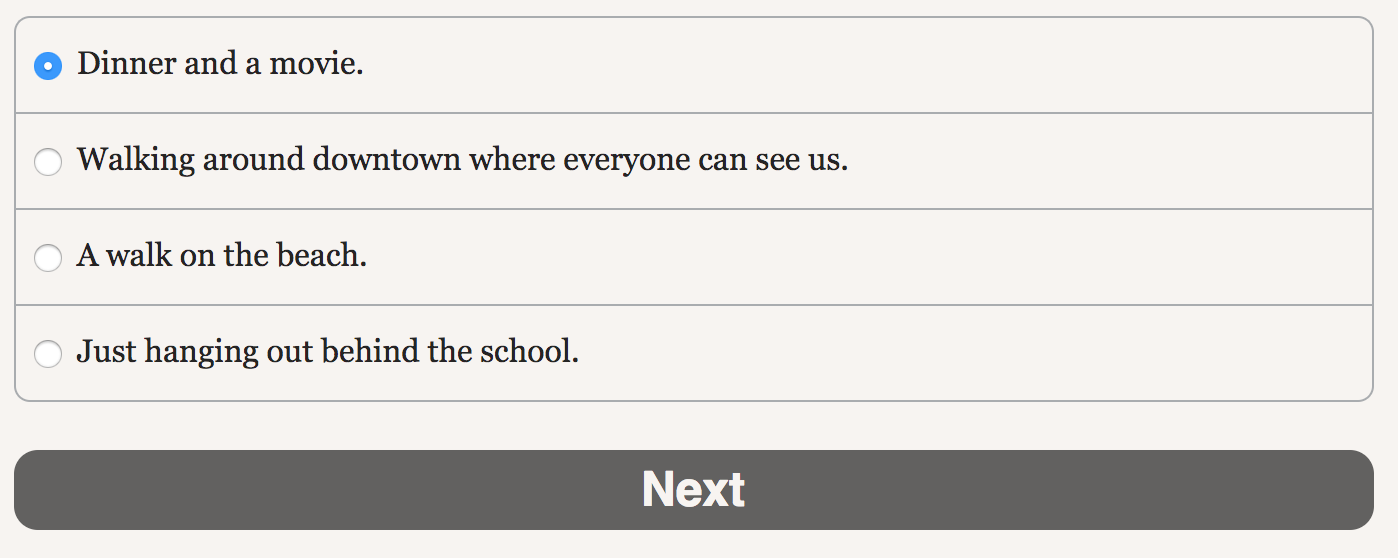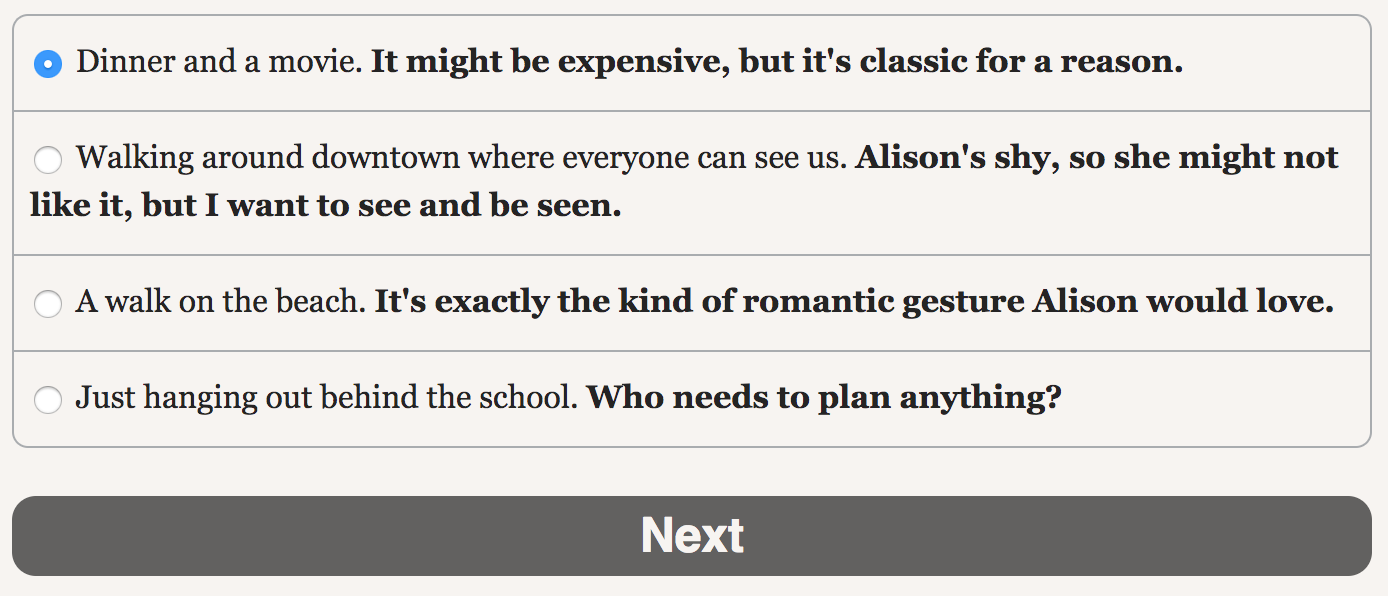Dec 22
2016
How to Write Intentional Choices
Posted by: Becky Slitt | Comments (0)
As part of our support for the Choice of Games Contest for Interactive Novels, we will be posting an irregular series of blog posts discussing important design and writing criteria for games. We hope that these can both provide guidance for people participating in the Contest and also help people understand how we think about questions of game design and some best practices. These don’t modify the evaluation criteria for the Contest, and (except as noted) participants are not required to conform to our recommendations–but it’s probably a good idea to listen when judges tell you what they’re looking for.
If these topics interest you, be sure to sign up for our contest mailing list below! We’ll post more of our thoughts on game design leading up to the contest deadline on January 31, 2018.
One of our core principles is that choices have to be meaningful. There are several dimensions to a meaningful choice: for instance, it has to have consequences; and it has to have emotional resonance for the player. Underlying those ideas, though, is the idea of intention. In order for a player to feel emotionally invested in their choices, they have to know why they’re choosing it, and they have to have some idea of what the consequences of that choice might be.
A standard practice in old choose-a-path gamebooks was to offer the options “Go right” or “Go left” without any more information about what the reader might find in each direction. The reader would have to choose randomly.
Then, they’d probably fall off a cliff.
More seriously, though, in a choose-a-path gamebook, you can easily flip back to start over, or peek ahead to see what happens with each option. That’s not possible in a Choice of Games game. The player needs to live with the consequences of their choices, and may feel very frustrated if they make a choice with one intention in mind only to discover that the actual results are different.
So intentionality is important in general. It’s especially important in a few particular circumstances. Specifically, when the potential consequences of an option are negative; and when different options within the same choice have different difficulty levels.
In these cases, it’s up to the author to make sure that the player has all the information they need to make the choice that they really want to make.
In practical terms, this means that before a choice, you should try to signal:
- the potential story results for each option
- which stats might be tested, if the option leads to a stat test
- the relative difficulty of each option, if some options are harder than others.
There are several ways that you can go about this.
One of the simplest and most effective methods is to communicate information about stats, story results, and difficulty in the text leading up to a choice. Here’s an excellent example of this kind of narration from Mecha Ace:
The PC is the pilot of a mecha – a giant robot spaceship – and they’re facing off in combat against their archrival Hawkins.
You examine your options as the Imperial mecha lunges forward. In any other situation, the obvious choice would be to be aggressive, counter-attacking and forcing your opponent onto the defensive. But with a pilot as skilled as Hawkins, you’re not sure if that would prove to be the best thing to do.
Of course, settling for a more defensive posture would prevent you from doing any damage to the enemy, but it would also mean that you could probably have a better chance at avoiding damage to your own machine, provided you kept calm.
It also occurs to you that you could use Hawkins’s verbosity against her. If your opponent is too busy monologuing to put all of her focus into the fight, it would be a lot easier to fend off her attacks.
Lastly, if you are fast enough—or lucky enough—you might even be able to withdraw from close combat, putting yourself out of the reach of the enemy ace’s monosaber.
And here are a few snippets of the code that follows, so that you can see how the text points to the stats that are being tested:
*choice
#Fight aggressively to cripple or destroy Hawkins's machine.
You lunge forward to meet the Imperial pilot's attack.
*if piloting >= 4
#Keep calm and fight defensively.
*if willpower >= 3
#Keep Hawkins talking to prevent her from focusing on the fight.
*if presence > 2
#Attempt to withdraw to keep out of reach.
*if speed >= 7
So, withdrawing tests speed: “if you are fast enough.” Taking up a defensive posture might be easier than attacking or trying to withdraw – ie, the stat test is lower for this than for either of the others – but it means that you’ll sacrifice the opportunity to do damage to your enemy. It’s implied that fighting aggressively will test your piloting, since the text cautions you that you’re facing “a pilot as skilled as Hawkins.”
The text clarifies the potential risks and rewards of each option, shows the relative difficulty of each option, and hints at the stats that might be tested for each one – in other words, it allows the player to make the choice with full intentionality.
To show why this is important, here’s a look at the choice on its own, without the additional text:

These options all make sense for the situation, and the text of each option tells the player exactly what their character is going to do. That’s a good start.
But the player doesn’t necessarily have enough information to choose the right one for them. What are the risks of each potential action? Is one option harder or easier than the others? What strengths and weaknesses might come into play with each one – or, to put it in game-mechanics terms, what stats might be tested? Does the first option test the PC’s piloting skill, weapons skill, or both? Does the last option test the PC’s speed, piloting skills, or both?
That’s why the text before the choice is important: to make sure that the player has all the information they need to take the action that best fits their goals.
Another way to convey this information is to put it in the text of the option itself. To take a lower-stakes example: here’s a scene from Psy High, in which the PC is choosing what to do on a date with their girlfriend Alison. This is how it would look if the text of the option only had the activities themselves, along with an abbreviated version of the code so that you can see the stat effects of each option:
What have you got planned?
*choice
Because Alison is very shy and very romantic, it makes sense that certain activities will appeal to her more than others. She won’t be happy if she’s in the middle of a crowd; she’ll like the simple beauty of a walk on the beach. It also makes sense that each activity has different benefits and drawbacks for the PC: going out to dinner costs more than going for a walk on the beach. Therefore, each potential date activity has different effects on the PC’s personal stats and on the stat that tracks their relationship with Alison.
But before making their choice, the player would see only:

It’s just a list of activities; the player has no way of knowing the effects of these choices, either on their relationship with Alison or on their other goals and stats.
Some players will want to be able to choose the activity that would make Alison happiest, but they have no way of knowing which one that will be, so they might be unpleasantly surprised if they choose one that makes her unhappy instead. Or, they might be willing to make a sacrifice in one area for the sake of a benefit in another area – but, again, they can’t tell how to do that, or even that the possibility of a sacrifice exists. A character who’s very concerned with their own social status might think that making Alison a little unhappy is worth it to increase their own popularity. Likewise, a character who’s strapped for cash might not want to spend $50 – or, they might think that expenditure is worth it to make Alison happy.
But in order for the choice to be intentional and meaningful, the player needs to know that they’re making those tradeoffs.
Therefore, here’s how that choice actually appears in the game:

The bolded text points the player towards some of those tradeoffs: the extra cost of going out to dinner, the increase in popularity that some players might like, etc. Now the player has all the information they need to make the choice they want, and to advance towards the goals that they want.
In conclusion, one of the best ways to make your choices meaningful is to make them intentional. To do that, give clues in the text about the potential story effects and stat effects of each option, and indicate when one option is easier or harder than the others.
Good luck!

 Steam
Steam Twitter
Twitter Facebook
Facebook Tumblr
Tumblr RSS Feed
RSS Feed

